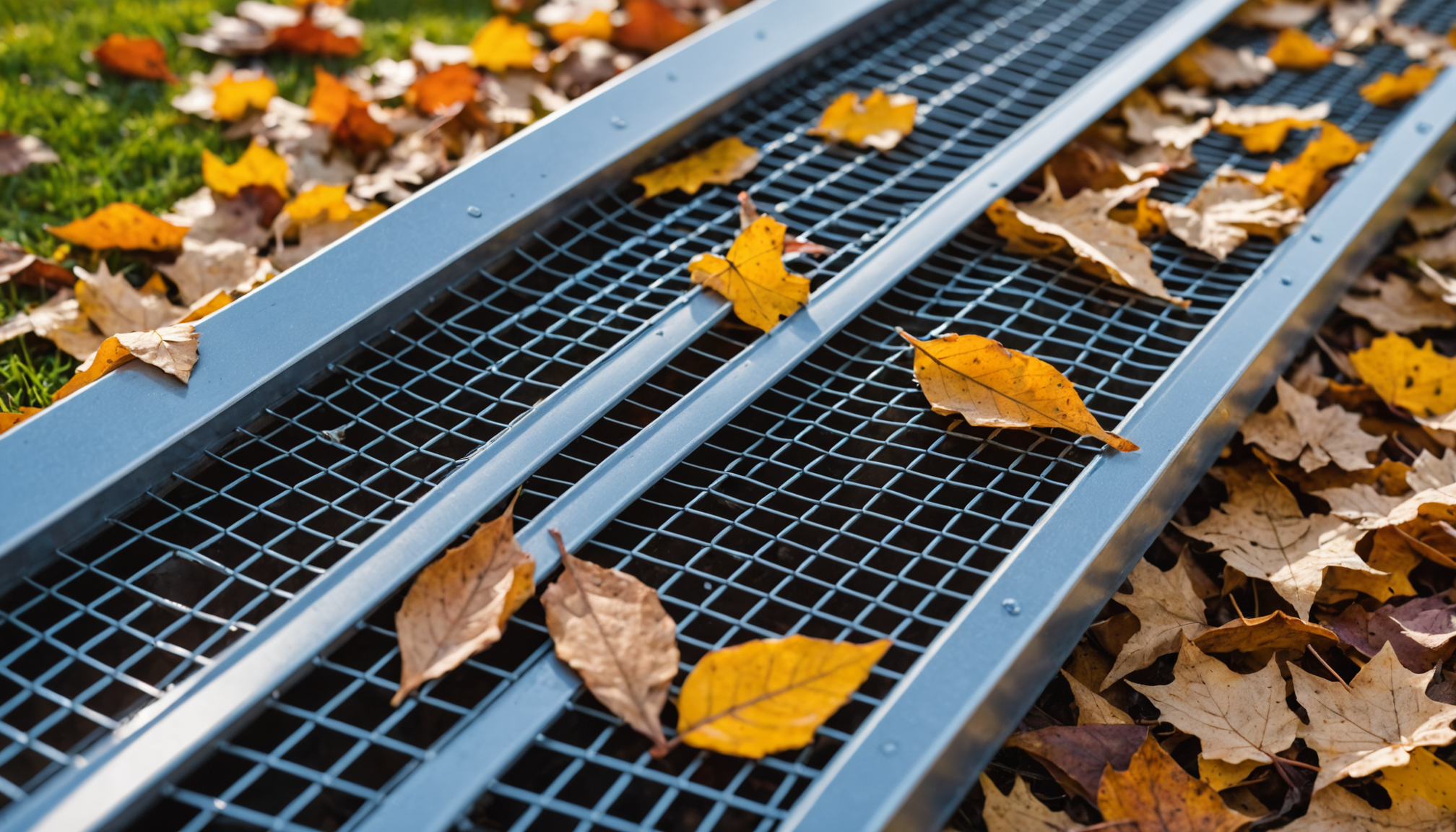When it comes to protecting your home from water damage, choosing the right gutter guard is paramount. There are various types available, each designed to address specific issues like debris buildup, pest control, and maintenance ease. Understanding these types will help homeowners make an informed decision that best suits their individual needs.
One of the most popular types of gutter guards is the mesh gutter guard. These are made of a thin metal sheet that has small holes punched throughout. They work by allowing water to enter while preventing sizeable debris such as leaves and twigs from clogging the gutters. Mesh guards are well-suited for homes located near trees, offering a balance between cost-effectiveness and efficiency.
Another option is the reverse curve gutter guard, sometimes referred to as surface tension guards. These are crafted with a unique design that directs water around a downward curve into the gutter while letting leaves and debris fall to the ground. This type is highly effective in managing large volumes of water but may require professional installation to ensure optimal performance.
Foam gutter guards represent a more budget-friendly solution. These are placed directly inside the gutter, allowing water to flow through the foam while blocking larger debris. Despite their ease of installation and affordability, foam guards might not be as durable as other types and may require more frequent replacements.
For those seeking a simple and quick-to-install option, brush gutter guards are noteworthy. They comprise cylindrical brushes that fit inside the gutter, letting water flow freely while trapping debris on the bristles. However, they may require regular cleaning since leaves and twigs can become entangled within the brushes.
Micro-mesh gutter guards, a superior variation of standard mesh guards, feature a fine mesh that stops even the smallest debris while allowing water to pass through easily. Though usually priced higher than other options, micro-mesh guards offer excellent protection and require little maintenance once installed.
Here is a comparison table summarizing these types of gutter guards:
| Type | Features | Advantages | Disadvantages |
| Mesh | Thin metal sheet with holes | Cost-effective, efficient for debris | May require occasional cleaning |
| Reverse Curve | Unique downward curve design | Effective in directing water, low maintenance | Typically requires professional installation |
| Foam | Fits inside gutters, allows water flow | Easy installation, affordable | Less durable, frequent replacement |
| Brush | Cylindrical brushes fitted inside gutters | Easy to install, some debris trapping | Regular cleaning needed, may clog |
| Micro-mesh | Fine mesh material | Excellent debris protection, durable | Higher cost |
Homeowners should weigh these options carefully, considering factors such as the climate in their region, proximity to trees, and their willingness to perform maintenance. Choosing the right type of gutter guard can significantly enhance the efficiency of your gutter system, ensuring that your home remains safe from potential water damage.
Comparison of materials
When evaluating gutter guard materials, it’s important to consider attributes such as durability, cost, and effectiveness. Here’s a step-by-step comparison of the materials commonly used in gutter guards, helping you choose the best option for your home.
1. Aluminum
– Durability: Aluminum is known for its longevity and resistance to rust, making it a popular choice for gutter guards exposed to the elements.
– Cost: It is usually moderately priced, providing a good balance between affordability and performance.
– Effectiveness: Aluminum is lightweight yet strong, effectively supporting the gutter guard structure while efficiently filtering debris.
2. Stainless Steel
– Durability: Exceptionally durable, stainless steel is highly resistant to corrosion and damage, even in harsh weather conditions.
– Cost: Generally more expensive than other materials, the higher upfront cost is often justified by its long lifespan.
– Effectiveness: It provides superior protection against even the smallest debris, including pine needles, due to the fine mesh used in many designs.
3. Vinyl
– Durability: While vinyl is resistant to rust, it may become brittle and crack over time, especially in extreme weather.
– Cost: Vinyl is often the most cost-effective option, making it appealing for budget-conscious homeowners.
– Effectiveness: Suitable for standard debris blocking, but it may not be as effective against finer particles compared to metal options.
4. Plastic
– Durability: Offers moderate resistance to weather conditions, though its lifespan can be shorter than metal counterparts under prolonged exposure.
– Cost: Low-cost and easy to handle, plastic gutter guards are an economical choice for temporary or low-impact applications.
– Effectiveness: Good for handling leaves and larger debris, but can sometimes warp or become less effective over time.
5. Copper
– Durability: Known for its natural resistance to mold and mildew, copper offers excellent durability and can last for decades.
– Cost: This material is typically the most expensive option, but its durability and aesthetic appeal can add value to your home.
– Effectiveness: Besides offering excellent protection against debris, copper also develops a patina over time, adding a unique visual appeal.
Homeowners should focus on the specific needs of their property and climate conditions when selecting materials. While stainless steel and copper offer durability and enhanced protection, the cost may not be justifiable for every situation. Aluminum provides a versatile option, balancing cost and performance, whereas vinyl and plastic serve well for those needing a budget-friendly solution. By carefully considering each material’s properties, you can select a gutter guard that effectively shields your home from water damage while fitting within your budget and aesthetic preferences.
Installation tips and tricks
Properly installing gutter guards can greatly enhance their effectiveness and longevity, ensuring that your home remains safeguarded from water-related damage. Here are some expert tips and tricks to guide you through the installation process and help you avoid common pitfalls.
First, start by thoroughly cleaning your existing gutters. This step cannot be overlooked, as installing gutter guards over clogged gutters defeats the purpose and can lead to further issues. Remove all debris, such as leaves and twigs, and rinse the gutters with water to ensure they are clean and clear.
Before moving on to the actual installation, measure your gutters accurately. Knowing the dimensions is crucial to purchasing the correct size of gutter guards. Ensure the fit is snug, as poorly fitting guards can allow debris to bypass the protection, while overly tight fits can damage the gutter system.
When installing guards, consider the angle and positioning. Proper alignment is key to maximizing water flow and minimizing debris accumulation. For mesh and micro-mesh guards, ensure that the mesh surface is slightly angled away from the roof edge. This positioning encourages debris to slide off rather than accumulate, while still letting water through efficiently.
For those opting for reverse curve gutter guards, professional installation is often recommended. These types require precise positioning to achieve their unique water-directing capabilities. Incorrect installation can reduce their effectiveness, so it’s worth consulting with a professional installer.
In terms of tools, most installations can be performed with standard household items such as a ladder, drill, and screwdriver. Safety should always be a priority, so ensure your ladder is stable and consider using a harness if your roof is steep or high.
When it comes to materials like foam or brush guards, securing them properly within the gutter is crucial. Foam inserts should fill the gutter without compressing, as compacted foam can reduce water flow. Brush guards should snugly fit inside, allowing the bristles to catch debris while maintaining unimpaired water movement.
In addition, it’s beneficial to perform a water flow test after installation. Using a hose, simulate rainfall to see how well the system handles water. Look for any overflow, which might indicate installation errors or the need for adjustments.
Finally, plan for regular inspections and maintenance post-installation. While gutter guards significantly reduce the frequency of gutter cleaning, periodic checks and cleanings help maintain optimal performance. Remove any debris from atop the guards and ensure that downspouts remain unobstructed.
By taking the time to carefully install and occasionally maintain your gutter guards, you can extend the life of your gutter system and protect your home from the detrimental effects of improper water management. Whether chosen for their ease of installation, cost, or performance, each type of gutter guard can be effectively implemented with the right approach.
Benefits of using gutter guards
Imagine a serene rainy day, where instead of worrying about potential water damage, you’re enjoying the sound of raindrops hitting your roof, confident that your home is fully protected. This peace of mind is one of the most compelling reasons to invest in gutter guards for your home. They offer numerous advantages that go beyond simply blocking debris.
First and foremost, they greatly reduce the frequency of gutter cleaning. Without guards, gutters tend to accumulate leaves, twigs, and other debris, necessitating frequent cleanouts to prevent clogs. Installing gutter guards minimizes this buildup, sparing you from the hazardous task of regularly climbing ladders to clear out your gutters. This not only saves you time but also reduces the risk of injury.
Moreover, gutter guards play a significant role in preventing damage to your home’s foundation. When gutters are clogged, water overflows and can pool near your foundation, leading to potential cracks and costly repairs. By ensuring that water flows smoothly through the gutters, guards direct rainwater away from your home, preserving the integrity of your foundation and preventing basement flooding.
The impact on your roof’s lifespan is another advantage. Stagnant water in clogged gutters can back up into your roof, causing rot and deterioration over time. With properly functioning gutter guards, water overflows and damage to the roof are minimized, extending its lifespan and reducing maintenance costs.
Additionally, these protective barriers can help deter pests. Without debris accumulation, pests such as rodents, birds, and insects are less likely to find your gutters a hospitable breeding ground. This is crucial not only for preventing infestations but also for maintaining the overall cleanliness and safety of your property.
Aside from preventing blockages, gutter guards contribute to efficient rainwater harvesting. If you use rainwater collection systems, cleaner water without debris interference means less filtering and higher quality water for irrigation or other uses.
Furthermore, they provide aesthetic benefits. Overflowing gutters can lead to unsightly streaks and stains on the siding of your home. By keeping gutters clear and ensuring proper drainage, guards help maintain the visual appeal of your home’s exterior.
Finally, investing in gutter guards is a financially sound decision. By preventing structural damage and reducing maintenance costs, such as roof repairs and frequent gutter cleanings, they can result in significant long-term savings. While initially there is an investment cost, the reduction in potential repair expenses often justifies this expenditure.
Remember, obtaining the full range of benefits from gutter guards largely depends on selecting the right type for your home and conditions, as well as ensuring proper installation. By choosing wisely and maintaining them well, you ensure that your home remains protected from the ravages of rain and the consequences of neglect.
How to maintain your gutter guards
To keep your gutter guards performing optimally, regular maintenance is crucial, though thankfully it’s minimal compared to unguarded gutters. Begin with periodic inspections, especially after major weather events, as these can cause debris accumulation or damage. Depending on your region and season, check them at least twice a year.
Start by visually assessing the guards from ground level or by using binoculars if your roof is high. Look for visible dirt, accumulated debris, or signs of damage. For a more thorough check, safely access your roof or use a stable ladder to reach the guards. Clear any twigs, leaves, or dirt from the guard surface, as this can impede water flow even if the guards are mostly doing their job.
For certain types of guards like foam or brush, it is advisable to remove them periodically to clear out any collected debris inside the gutter itself. This ensures that the guards continue to function as intended and that the gutters retain their primary role in water direction. Pay particular attention to downspouts as they are prone to clogs that can back up water along the entire system.
When cleaning or removing debris, a blower can be useful. It is less intrusive than water, which can sometimes compact dirt or push it further into the gutters. Alternatively, a gentle spray from a garden hose can help clear lighter debris and test the water flow through the system, ensuring no blockages.
Remember, even durable materials can suffer over time. Inspect your guards for any signs of wear such as rusting in metal guards, cracking in vinyl, or warping in plastic. Address these issues promptly; sometimes a little maintenance can extend the system’s longevity or indicate when a replacement might be needed.
Preventative care can be beneficial too. Trim overhanging branches that drop leaves or shed seeds into your gutters. This not only reduces the debris load in the guards but also helps keep gutters and roofs in better overall condition.
By proactively maintaining your gutter guards, you ensure they continue to perform effectively, giving your home the protection it needs from potential water damage. With minimal effort, you can enjoy the long-term benefits of a well-maintained gutter guard system, keeping your property safe and sound.
In conclusion, selecting the right gutter guards and maintaining them effectively can significantly alleviate the challenges of gutter management. By understanding the types, materials, and installation processes, you can make armed decisions suited to your home’s requirements. Consistent maintenance will surely keep your guards and gutters in prime condition, providing safety, savings, and peace of mind from water damage.


